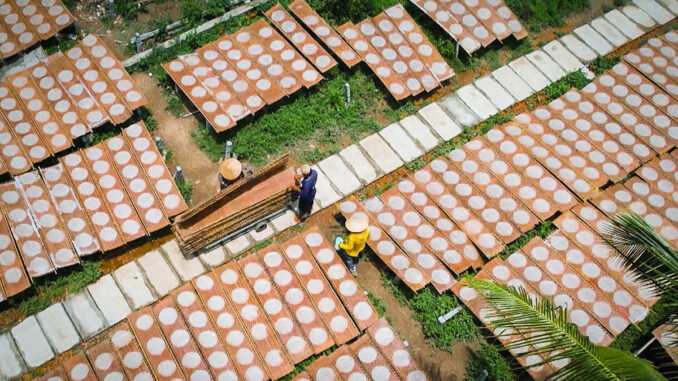
CAN THO – Coming to Thuan Hung rice paper craft village, visitors can experience the baking process, and the intangible cultural heritage of Tay Do.

Rice paper is a specialty of the South. If the Southeast has Tay Ninh rice paper, the Southwest has Thuan Hung rice paper.
A representative of the Department of Culture and Information of Thot Not district said that Thuan Hung craft village (Thuan Hung ward, Thot Not district, Can Tho city) was formed in the middle of the 19th century. The craft of making rice paper here was recognized by the Ministry of Culture, Sports and Tourism as an intangible cultural heritage in May.

When stepping foot to Tan An hamlet, Thuan Hung ward during his trip on July 15, Nguyen Dinh Hoang Khanh (29 years old, HCMC) saw that the surrounding area was filled with drying racks made from coconut leaves lined up along the banks of Thom Rom canal. , leaning against the wall, fence or spread across the yard. Above are hand-rolled rice paper cakes that are neatly arranged, waiting for the sun to dry.

Rice paper is not a strange dish, even associated with the childhood of many people like Khanh. “But this is the first time I have witnessed firsthand the stages to make a rice paper,” he said.
Duong Thi Cam Dung, a rice paper maker in Tan An hamlet, said that rice paper flour is rice flour produced in Thot Not but left after half a year. “Making new rice when dipping in cake water is disintegrating, baking is not crispy. If you make old rice, the cake will lose its sweetness,” said Ms. Dung.
Thuan Hung people have their own secret in the ratio of flour to water so that when the water evaporates, the cake is not too thin, easily torn and not too thick.

According to Ms. Dung, to make rice paper requires three people, each person performing a stage: rolling the cake, spreading the cake and drying the cake.
The process of coating the cake requires the ingenuity of the maker to make the cake have a beautiful round shape. The dough is measured with a small coconut shell, poured into a flat pan with a handle (pictured) while waiting for the front layer to cook.
Pour the batter from the pan onto the steamer and then quickly rub the dough about three times with the flat bottom to spread the dough evenly. If you are not familiar with your hands, slow down, the cake will be lumped, the dough is thin and thick, and the cake is easy to crack and break when drying.

Ladles of powder were poured out and rubbed evenly on a cloth stretched over a pot of simmering water. Thuan Hung people use rice husk stoves to make rice paper. Use a swing made from coconut leaves face down for about 10 seconds to cook evenly.

The cooked cake is lifted from the surface of the steamer by a specialized tool, a towel-wrapped handle. Because the cake is cooked but still wet, it is easy to cling to the fabric. The maker skillfully spreads the cake flat on the drying rack because the layer of cooked cake is very thin, easy to tear.

Each cake has a diameter of 40 cm, which fits the width of the drying rack. The wet cake layer clings to the surface of each slice of bamboo, forming beautiful patterns hidden underneath.
The drying of the cake also needs time to dry the cake to medium (about 30 minutes), retain a certain amount of water to create toughness, not brittle, easy to break. Cakes that are drying in the rain will become wet, mushy and may disintegrate into water. At the same time, workers need to have skills in drying so that the cake after drying does not warp or warp, keeping its beautiful round shape.

The dry cake is no longer white thanks to the rice flour but turns transparent. The maker skillfully removed each piece of cake from the rig, folded it into dozens and then flattened the surface before delivering the goods.
Careful selection of inputs, meticulous baking process makes the rice paper soft, supple and fragrant with rice and especially “hundreds of them as one”, commented Mr. Khanh. This is also a factor that makes up the brand of this traditional craft village.

Currently, people produce 6 types of rice paper: dipped rice paper, spring roll cake, chili rice paper, coconut rice paper, sweet rice paper and ruoc rice paper. Each type comes in several sizes.
Consumers can easily find Thuan Hung rice paper at markets, grocery stores, supermarkets or order directly at Thuan Hung rice paper ovens. In addition to serving domestic demand, Thuan Hung rice paper is also exported to Cambodia.

Currently, Thuan Hung craft village has about 100 households in 4 hamlets of Tan An, Tan Phu, Tan Thanh and Tan Phuoc 1 making rice paper. Only a few households invest in machinery, most of them still produce by manual method, said a representative of the Information and Culture Department of Thot Not district.
In the past two centuries, Thuan Hung rice paper craft village has been preserved and maintained by the people in the form of “heredity”, said Ms. Dung (yellow shirt).
“Making a real rice paper is very sophisticated and takes a lot of effort. Fortunately, the people’s perseverance in keeping the job paid off when the craft village was recognized as a national intangible cultural heritage, becoming a national intangible cultural heritage. the pride of local people,” Khanh said.
($1=24,000 VND)
Photo: Internet (Vinlove.net)
